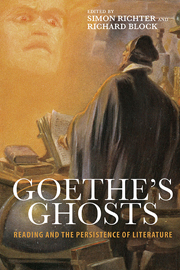Book contents
- Frontmatter
- Contents
- Introduction—Ghosts and the Machine: Reading with Jane Brown
- Part I The Ghosts of Goethe's Past
- 1 Egologies: Goethe, Entoptics, and the Instruments of Writing Life
- 2 Goethe's Haunted Architectural Idea
- 3 “Über allen Gipfeln”: The Poem as Hieroglyph
- 4 Goethe's Hauskapelle and Sacred Choral Music
- 5 From Haunting Visions to Revealing (Self-)Reflections: The Goethean Hero between Subject and Object
- Part II The Ghost That Keeps on Giving
- Part III Spirited Encounters
- Bibliography of Jane K. Brown's Publications
- Notes on the Contributors
- Index
1 - Egologies: Goethe, Entoptics, and the Instruments of Writing Life
from Part I - The Ghosts of Goethe's Past
Published online by Cambridge University Press: 05 March 2014
- Frontmatter
- Contents
- Introduction—Ghosts and the Machine: Reading with Jane Brown
- Part I The Ghosts of Goethe's Past
- 1 Egologies: Goethe, Entoptics, and the Instruments of Writing Life
- 2 Goethe's Haunted Architectural Idea
- 3 “Über allen Gipfeln”: The Poem as Hieroglyph
- 4 Goethe's Hauskapelle and Sacred Choral Music
- 5 From Haunting Visions to Revealing (Self-)Reflections: The Goethean Hero between Subject and Object
- Part II The Ghost That Keeps on Giving
- Part III Spirited Encounters
- Bibliography of Jane K. Brown's Publications
- Notes on the Contributors
- Index
Summary
On 13 April 1813, Goethe received a small booklet in the mail titled “Einige neue Versuche und Beobachtungen über Spiegelung und Brechung des Lichtes” (A few new experiments and observations on the reflection and refraction of light). It was an offprint of an article that had appeared in the Journal für Chemie und Physik written by Goethe's friend thomas Seebeck, who was now residing in nuremberg. it concerned the question of the polarity of light, which was observable through the combined effects of double refraction and multiple reflection and which had been treated two years earlier in a prize-winning article by the French researcher Etienne Louis Malus, “Théorie de la double réfraction” (1811).
Malus's work would go on to become the single most important influence for optical research for the next two decades until the wider acceptance of Augustin Fresnel's wave theory of light over the course of the 1820s. It had begun as an inquiry into the well-known phenomenon of double refraction, the way crystals such as Iceland spar could split a ray of light into two separate rays, initially observed by Erasmus Bartholin in 1669. What interested Malus was the way the two rays behaved differently when subsequently reflected off another transparent surface.
- Type
- Chapter
- Information
- Goethe's GhostsReading and the Persistence of Literature, pp. 17 - 36Publisher: Boydell & BrewerPrint publication year: 2013



